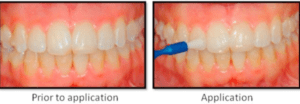The advancements in preventive measures have significantly transformed oral health practices. Among these innovations, dental varnish and fluoride treatments stand out as vital tools in the fight against tooth cavities and enamel erosion. These treatments help strengthen teeth and provide a protective barrier against harmful bacteria and acids.
What is a varnish?
Dental varnishes are thin coatings applied to the surface of teeth by clinicians and they serve multiple purposes such as sealing exposed dentin, reducing tooth sensitivity, and most important preventing cavities.
One of the primary ingredients in dental varnishes is fluoride, as quoted in various scientific articles, it is a naturally occurring mineral known for its ability to strengthen tooth enamel. This mineral plays an integral role in preventing tooth decay by remineralizing weakened enamel and making teeth more resistant to acid attacks from plaque bacteria, thereby reducing the chances of decay.
What does a fluoride varnish do?
Fluoride varnishes, specifically, are highly concentrated forms of fluoride that attach to the tooth surface upon application. This adherence allows the fluoride to remain in contact with the enamel for a long period, maximizing its effectiveness in preventing cavities. Research has shown that fluoride varnishes can reduce cavity formation by up to 30-40%, making them a valuable tool in preventive dental care.
Application Process
The application of dental varnishes is a simple procedure performed during a routine dental appointment.
- Cleaning of the tooth surface
- Varnish is applied with a brush or applicator directly onto the enamel.
- Patients are advised to avoid eating or drinking for a brief period to allow the varnish to fully adhere and maximize its benefits.
- This simple yet effective treatment can provide long-lasting protection against tooth decay, particularly in high-risk individuals such as children and those with a history of dental caries.

Coming on to the effectiveness of fluoride varnishes lies in their ability to enhance the natural remineralization process of teeth. By replacing lost minerals and strengthening enamel, these treatments not only prevent cavities but also improve overall oral health. Long-term studies have demonstrated a significant reduction in dental caries among populations regularly receiving fluoride varnish applications, underscoring its role as a cornerstone of modern preventive dentistry.
Dental varnishes come in various formulations tailored to different patient needs. Some may contain additional ingredients such as calcium phosphate complexes or antimicrobial agents to further enhance their protective properties. For patients with hypersensitivity or specific dental conditions, alternative varnishes with customized compositions may be recommended by dental professionals to address individual oral health concerns effectively.
For dental practitioners, integrating fluoride varnish applications into routine care protocols is crucial for promoting oral health and preventing common dental issues. Educating patients about the benefits of these treatments and their role in maintaining healthy teeth can empower individuals to take proactive steps in their oral care regimen. Regular dental visits combined with consistent oral hygiene practices, including brushing with fluoride toothpaste and flossing, complement the protective effects of varnishes in preserving natural tooth structure.
In public health initiatives, fluoride varnish programs have proven instrumental in reaching underserved populations and reducing oral health disparities. By making preventive treatments accessible in community settings such as schools or clinics, dental professionals can effectively reach children and adults who may otherwise lack regular dental care. These programs not only improve oral health outcomes but also contribute to overall well-being by preventing dental pain and complications associated with untreated cavities.
Looking ahead, ongoing research continues to explore new formulations and delivery methods for dental varnishes and fluoride treatments. Advances in nanotechnology, for instance, may lead to the development of varnishes with enhanced durability and targeted delivery systems for specific dental conditions. Additionally, the integration of digital technologies in dentistry could streamline the application process and enhance precision in treatment outcomes, further optimizing the effectiveness of preventive dental care strategies.
Conclusion
To conclude dental varnishes and fluoride treatments represent crucial advancements in preventive dentistry, offering effective solutions for strengthening enamel, preventing cavities, and promoting overall oral health.
By utilizing the protective properties of fluoride through varnish applications, dental professionals can encourage patients to maintain healthy smiles for years to come. As these treatments continue to evolve and expand, their role in enhancing oral hygiene and reducing dental disease remains indispensable in modern dental practice.

